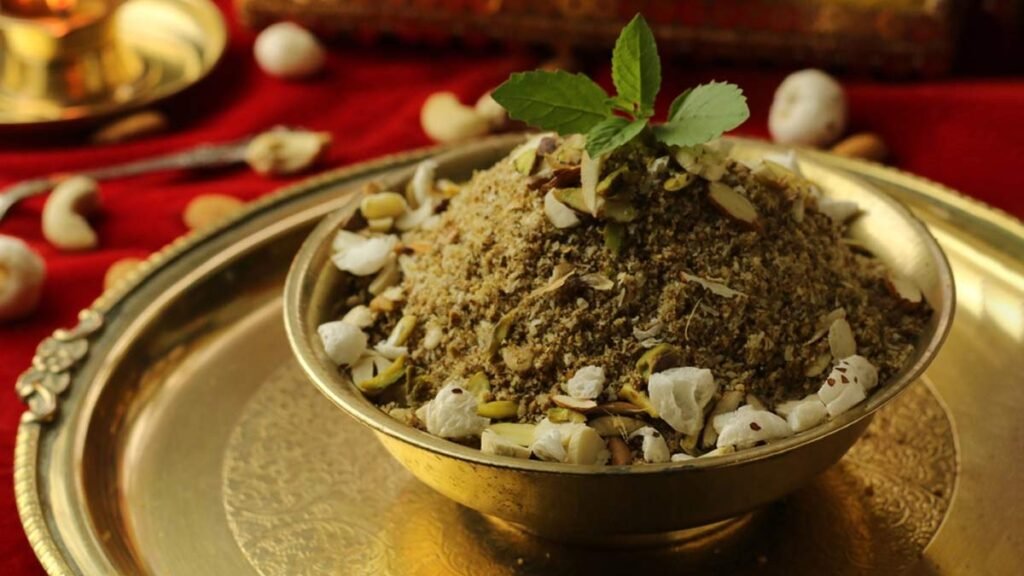How to Make Dhaniya Panjiri: A Traditional Delight

Introduction
Dhaniya Panjiri, a traditional Indian sweet, is not just a treat for the taste buds but also holds a special place in Hindu rituals, especially during the Janmashtami festival. Made primarily from coriander powder, this delicacy is both nutritious and symbolic. Let’s explore this unique recipe, its cultural significance, and some handy tips.
Cultural Significance of Dhaniya Panjiri
Dhaniya Panjiri, while a delicious snack, is deeply rooted in Indian culture and is especially made during Krishna Janmashtami. It is offered as prasad (a religious offering) to Lord Krishna. The use of specific ingredients like coriander seeds is not only for flavor but also for their health benefits.
Ingredients and Quantities
- Coriander seed powder (Dhaniya powder): 1 cup
- Powdered sugar: ½ cup
- Ghee (clarified butter): ¼ cup
- Chopped almonds: 2 tablespoons
- Chopped cashews: 2 tablespoons
- Edible gum (gond): 1 tablespoon
- Grated coconut: 2 tablespoons
- Kamarkas (Butea frondosa): 1 teaspoon
- Cardamom powder: ½ teaspoon
Step-by-Step Recipe
1. Roasting the Ingredients
In a pan, heat ghee and roast the edible gum until it puffs up. Remove and crush it into smaller pieces. Then, roast the kamarkas in the same ghee.
2. Preparing the Dhaniya Mixture
In the remaining ghee, roast the coriander seed powder on low heat until it changes color slightly and emits a pleasant aroma.
3. Adding Nuts and Flavors
Add chopped almonds, cashews, and grated coconut to the mixture, roasting them lightly.
4. Combining the Ingredients
Turn off the heat and let the mixture cool. Once cool, add powdered sugar, cardamom powder, crushed edible gum, and kamarkas. Mix well.
5. Serving and Storage
Dhaniya Panjiri is ready to be served as prasad or a nutritious snack. Store in an airtight container for up to a week.
Precautions and Tips
- Use a heavy-bottomed pan to prevent burning.
- Always roast on low heat to maintain the flavors.
- Ensure all ingredients, especially the coriander powder, are fresh for the best taste.
- Cool the mixture completely before adding sugar to prevent it from melting.
10 FAQs About Dhaniya Panjiri
1. Can I use regular sugar instead of powdered sugar?
Powdered sugar blends better, but you can grind regular sugar into a fine powder and use it.
2. Is Dhaniya Panjiri only made during Janmashtami?
While it is traditionally made for Janmashtami, it can be enjoyed anytime as a healthy snack.
3. Can I skip edible gum and kamarkas?
They add to the texture and nutritional value, but you can omit them if unavailable.
4. How long does Dhaniya Panjiri stay fresh?
Stored in an airtight container, it stays fresh for about a week.
5. Can I add other dry fruits to the Panjiri?
Yes, you can add your choice of dry fruits for additional flavor and nutrition.
6. Is there a vegan alternative to ghee in this recipe?
You can use coconut oil as a vegan alternative, but it will alter the traditional taste.
7. Can Dhaniya Panjiri be consumed as part of a regular diet?
Yes, in moderation, it can be a nutritious addition to a regular diet.
8. Why is coriander seed powder the main ingredient?
Coriander seeds have multiple health benefits and are traditionally used for their unique flavor.
9. Can diabetic individuals consume Dhaniya Panjiri?
Due to the presence of sugar, it’s advisable for diabetic individuals to consult their doctor before consumption.
10. How do I ensure my Panjiri has the right texture?
The key is in the roasting process. Roast on low heat until the mixture is fragrant and changes color slightly.

Conclusion
Dhaniya Panjiri is more than just a sweet treat; it’s a blend of tradition, health, and spirituality. Whether you’re preparing it for a festival or as a nutritious snack, its unique taste and health benefits make it a delightful choice. Embrace this traditional recipe and enjoy the flavors that have been cherished in Indian households for generations.
Similar blog posts are continuously uploaded on our website Airynews.com. For more details click here.









